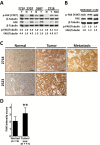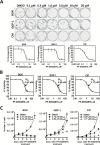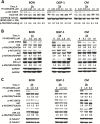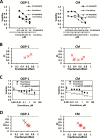Targeting Focal Adhesion Kinase and Resistance to mTOR Inhibition in Pancreatic Neuroendocrine Tumors
- PMID: 25971297
- PMCID: PMC4554194
- DOI: 10.1093/jnci/djv123
Targeting Focal Adhesion Kinase and Resistance to mTOR Inhibition in Pancreatic Neuroendocrine Tumors
Abstract
Background: Focal adhesion kinase (FAK) mediates survival of normal pancreatic islets through activation of AKT. Upon malignant transformation of islet cells into pancreatic neuroendocrine tumors (PanNETs), AKT is frequently overexpressed and mutations in the AKT/mTOR pathway are detected. Because mTOR inhibitors rarely induce PanNET tumor regression, partly because of feedback activation of AKT, novel combination strategies are needed to target FAK/AKT/mTOR signaling.
Methods: We characterized the activation of FAK in PanNETs using immunohistochemistry and Western blot analysis and tested the FAK inhibitor PF-04554878 in human PanNET cells in vitro and in vivo (at least three mice per group). In addition, we evaluated the effect of combined FAK and mTOR inhibition on PanNET viability and apoptosis. All statistical tests were two-sided.
Results: We found that FAK is overexpressed and hyperphosphorylated in human PanNETs and that PF-04554878 strongly inhibited FAK (Tyr397) autophosphorylation in a dose-dependent manner. We found that PF-04554878 inhibited cell proliferation and clonogenicity and induced apoptosis in PanNET cells. Moreover, oral administration of PF-04554878 statistically significantly reduced tumor growth in a patient-derived xenograft model of PanNET (P = .02) and in a human PanNET xenograft model of peritoneal carcinomatosis (P = .03). Importantly, PF-04554878 synergized with the mTOR inhibitor everolimus by preventing feedback AKT activation.
Conclusions: We demonstrate for the first time that FAK is overexpressed in PanNETs and that inhibition of FAK activity induces apoptosis and inhibits PanNET proliferation. We found that the novel FAK inhibitor PF-04554878 synergizes with everolimus, a US Food and Drug Administration-approved agent for PanNETs. Our findings warrant the clinical investigation of combined FAK and mTOR inhibition in PanNETs.
© The Author 2015. Published by Oxford University Press. All rights reserved. For Permissions, please e-mail: journals.permissions@oup.com.
Figures






Similar articles
-
Therapeutic Benefit of Selective Inhibition of p110α PI3-Kinase in Pancreatic Neuroendocrine Tumors.Clin Cancer Res. 2016 Dec 1;22(23):5805-5817. doi: 10.1158/1078-0432.CCR-15-3051. Epub 2016 May 25. Clin Cancer Res. 2016. PMID: 27225693 Free PMC article.
-
Synergism between the mTOR inhibitor rapamycin and FAK down-regulation in the treatment of acute lymphoblastic leukemia.J Hematol Oncol. 2016 Feb 18;9:12. doi: 10.1186/s13045-016-0241-x. J Hematol Oncol. 2016. PMID: 26892465 Free PMC article.
-
Rationale and protocol of the MetNET-1 trial, a prospective, single center, phase II study to evaluate the activity and safety of everolimus in combination with octreotide LAR and metformin in patients with advanced pancreatic neuroendocrine tumors.Tumori. 2014 Nov-Dec;100(6):e286-9. doi: 10.1700/1778.19298. Tumori. 2014. PMID: 25688512 Clinical Trial.
-
PI3K/Akt/mTOR pathway inhibitors in the therapy of pancreatic neuroendocrine tumors.Cancer Lett. 2013 Jul 10;335(1):1-8. doi: 10.1016/j.canlet.2013.02.016. Epub 2013 Feb 16. Cancer Lett. 2013. PMID: 23419523 Review.
-
Current understanding of the molecular biology of pancreatic neuroendocrine tumors.J Natl Cancer Inst. 2013 Jul 17;105(14):1005-17. doi: 10.1093/jnci/djt135. Epub 2013 Jul 9. J Natl Cancer Inst. 2013. PMID: 23840053 Free PMC article. Review.
Cited by
-
Radiosensitization by Kinase Inhibition Revealed by Phosphoproteomic Analysis of Pancreatic Cancer Cells.Mol Cell Proteomics. 2020 Oct;19(10):1649-1663. doi: 10.1074/mcp.RA120.002046. Epub 2020 Jul 10. Mol Cell Proteomics. 2020. PMID: 32651227 Free PMC article.
-
C1QA and COMP: plasma-based biomarkers for early diagnosis of pancreatic neuroendocrine tumors.Sci Rep. 2023 Nov 29;13(1):21021. doi: 10.1038/s41598-023-48323-x. Sci Rep. 2023. PMID: 38030709 Free PMC article.
-
Back to the future: targeting the extracellular matrix to treat systemic sclerosis.Nat Rev Rheumatol. 2023 Nov;19(11):713-723. doi: 10.1038/s41584-023-01032-1. Epub 2023 Oct 3. Nat Rev Rheumatol. 2023. PMID: 37789119 Review.
-
Translational Diagnostics and Therapeutics in Pancreatic Neuroendocrine Tumors.Clin Cancer Res. 2016 Oct 15;22(20):5022-5029. doi: 10.1158/1078-0432.CCR-16-0435. Clin Cancer Res. 2016. PMID: 27742788 Free PMC article. Review.
-
Phase 2 study of the focal adhesion kinase inhibitor defactinib (VS-6063) in previously treated advanced KRAS mutant non-small cell lung cancer.Lung Cancer. 2020 Jan;139:60-67. doi: 10.1016/j.lungcan.2019.10.033. Epub 2019 Nov 4. Lung Cancer. 2020. PMID: 31739184 Free PMC article. Clinical Trial.
References
-
- Sankhala K, Giles FJ. Potential of mTOR inhibitors as therapeutic agents in hematological malignancies. Expert Rev Hematol. 2009;2(4):399–414. - PubMed
Publication types
MeSH terms
Substances
LinkOut - more resources
Full Text Sources
Other Literature Sources
Medical
Miscellaneous

